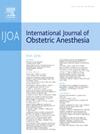Environmental and occupational risks with use of nitrous oxide (Entonox®) for labour analgesia: a qualitative analysis of midwives’ attitudes in the United Kingdom
IF 2.6
3区 医学
Q2 ANESTHESIOLOGY
引用次数: 0
Abstract
Background
Nitrous oxide carries significant environmental impact and has been linked to harm related to occupational exposure. In the United Kingdom, midwives are primarily responsible for administering nitrous oxide in the form of Entonox®. The aim of this study was to understand midwives’ perceptions related to the effects of nitrous oxide and barriers to change in the pursuit of net zero emissions.
Methods
This qualitative study was conducted at a single teaching hospital. An interview guide was developed for the conduct of this study with thematic analysis conducted using an inductive approach to determine common themes. A total of 10 participants consented and participated in semi-structured interviews.
Results
Three themes were identified; mixed awareness of environmental and occupational risk; midwifery culture as a barrier to change; and the identification of drivers for innovation and change.
Conclusions
Efforts to mitigate the environmental and occupational effects of nitrous oxide may require focused early educational policies and engagement with midwives to co-design demand- and supply-side mitigations to reduce harmful emissions from Entonox® delivery.
使用一氧化二氮(Entonox®)分娩镇痛的环境和职业风险:对英国助产士态度的定性分析
一氧化二氮对环境有重大影响,并与职业接触造成的危害有关。在英国,助产士主要负责以Entonox®的形式管理一氧化二氮。这项研究的目的是了解助产士对一氧化二氮影响的看法,以及在追求净零排放的过程中改变的障碍。方法在某教学医院进行定性研究。为开展这项研究制定了一份访谈指南,并使用归纳方法进行主题分析,以确定共同主题。共有10名参与者同意并参加了半结构化访谈。结果确定了三个主题;对环境和职业风险的混合意识;助产士文化是变革的障碍;以及识别创新和变革的驱动力。结论减轻一氧化二氮对环境和职业的影响可能需要有针对性的早期教育政策和助产士的参与,共同设计需求方和供应方的缓解措施,以减少Entonox®分娩过程中的有害排放。
本文章由计算机程序翻译,如有差异,请以英文原文为准。
求助全文
约1分钟内获得全文
求助全文
来源期刊
CiteScore
4.70
自引率
7.10%
发文量
285
审稿时长
58 days
期刊介绍:
The International Journal of Obstetric Anesthesia is the only journal publishing original articles devoted exclusively to obstetric anesthesia and bringing together all three of its principal components; anesthesia care for operative delivery and the perioperative period, pain relief in labour and care of the critically ill obstetric patient.
• Original research (both clinical and laboratory), short reports and case reports will be considered.
• The journal also publishes invited review articles and debates on topical and controversial subjects in the area of obstetric anesthesia.
• Articles on related topics such as perinatal physiology and pharmacology and all subjects of importance to obstetric anaesthetists/anesthesiologists are also welcome.
The journal is peer-reviewed by international experts. Scholarship is stressed to include the focus on discovery, application of knowledge across fields, and informing the medical community. Through the peer-review process, we hope to attest to the quality of scholarships and guide the Journal to extend and transform knowledge in this important and expanding area.

 求助内容:
求助内容: 应助结果提醒方式:
应助结果提醒方式:


